It’s not a secret that I am the world’s biggest Luigi’s Mansion fan: I’ve been playing the game every October since it launched in 2001, and I still manage to write about the game several times a year right here on Nintendo Wire. Back in March, my not-so-secret hopes were realized when Nintendo announced that they were remaking my favorite game of all-time, and to top it off, it would finally be playable in 3D as it was always intended. I’ve spent some time with the remake over the last few days, and while the game is still as classic as ever and looks great in 3D, it remains largely the same as it was back in 2001.
The younger, greener Mario brother has mysteriously won a mansion in the middle of the woods, and has invited his red-clad brother to join him on an adventure through its halls; however, when Luigi arrives at the mansion he discovers that Mario is missing, and the mansion is stuffed to the rafters with ghosts. Professor E. Gadd arrives to save the day, and teaches Luigi the ins and outs of ghost hunting with the trusty ghost-sucker, the Poltergust 3000. As Luigi travels through the mansion, he begins to reclaim each of the portrait ghosts that have escaped from E. Gadd’s gallery. Along the way he also uncovers the truth behind Mario’s disappearance, and it all has to do with those nasty Boos, who always seem to be up to no good.
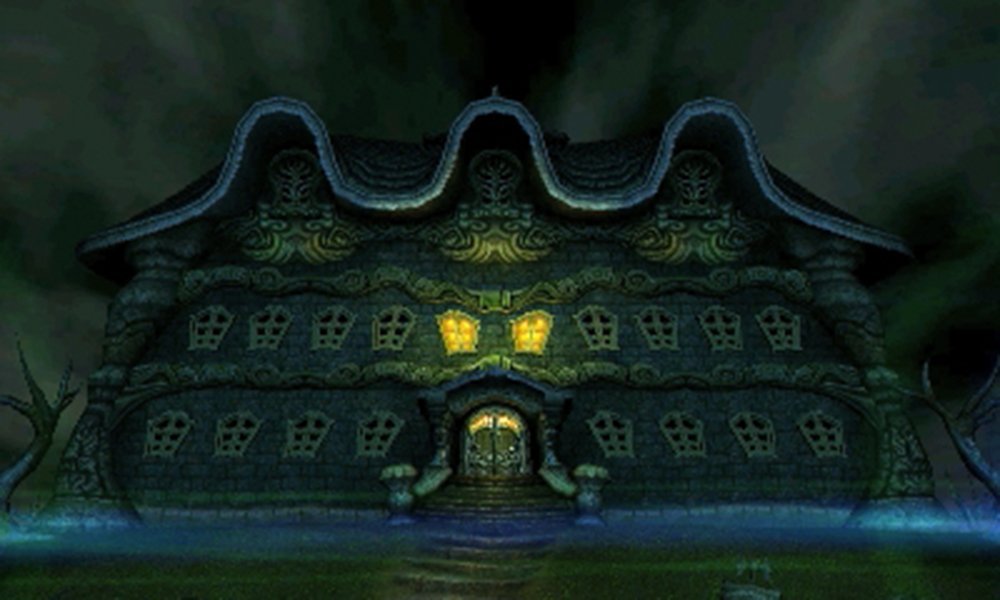
What you can expect from the controls
Nearly all of the original game is intact in this 3DS remake, wandering through the mansion, taking care of ghosts as you go, collecting money and Boos — it’s all still there. What has changed are most of the controls, which took some time to get used to. Gone is the ease of use of the GameCube’s C-stick, and in its place we have motion controls, which admittedly work pretty well once you get the hang of them. New 3DS players, and those who own a Circle Pad Pro, can still use C-stick controls, though the little nub on the New 3DS is rather cumbersome, and I found myself abandoning any attempt to use it almost immediately. Given the nature of the Circle Pad Pro, I’d imagine that it’s the option closest to the original’s control scheme, though still not a perfect match given how slippery the 3DS Circle Pad tends to be. The 3DS Circle Pad also leaves a little to be desired when it comes to the gameplay, as I found my thumb slipping around on it pretty often, especially during long sequences of suction while facing Portrait Ghosts. When I’m normally getting gold portrait frames on most, of not all, ghosts in the mansion in the GCN version, I found myself getting silver frames more often than anything else, with some late-mansion ghosts escaping more than once and dropping to a bronze frame thanks to the slippery Circle Pad.
The motion controls are paired with a clever use of the B-button that is more complex than it appears at first as well, and after some practice I was able to easily handle them in order to accomplish what I needed to. Holding R activates the vacuum and tilting the system up or down will move the stream of suction accordingly. Vacuuming also triggers a sidestep mode, which will keep Luigi, and the Poltergust, facing one direction. Holding down B while vacuuming takes him out of sidestep mode and allows you to spin in a circle, and aim the Poltergust all around the room. Using the motion controls for up and down aiming in conjunction with knowing when to hold B took a bit to get the hang of, but once it clicked I was able to take down even Boolossus with ease. Keep in mind that this control combination is inverted whenever Luigi is using the flashlight in a dark room. You’re able to move around the room freely with Luigi facing whichever direction point him in, while holding B triggers sidestep mode and motion controls, and is the only way to point your flashlight towards the ceiling and floor, which took also took a second for me to grasp. The controls, overall, are not as perfect as they were in the original game, but Grezzo took the limitations set by the 3DS and provided a rather creative solution that feels good to use once you get a feel for it.
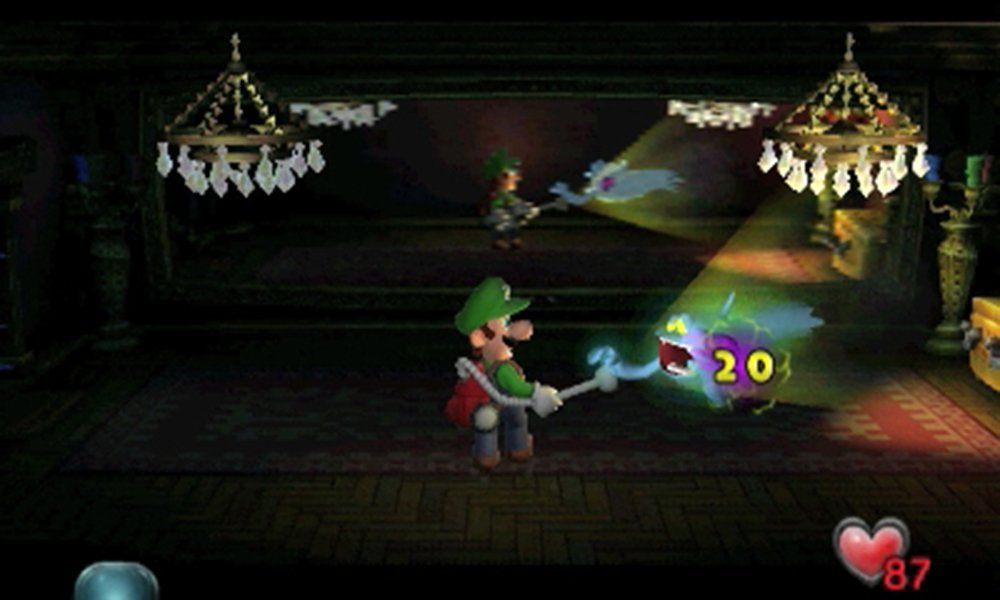
Spooky aesthetics and the beyond
Moving the game from the GameCube to the 3DS was never going to be an easy task, especially when it comes to how the game would look, which was especially important in a game that relies on atmosphere as much as Luigi’s Mansion does. The dark rooms appear brighter on the 3DS, which works out well for the tiny screen, but it does take away a bit of the haunting feeling the original had. The textures almost all appear to be new and higher quality, which is really noticeable when viewing close-up shots of doorknobs as Luigi unlocks them; on the downside, these close-up shots look really plain and appear to be missing some lighting details. The dynamic shadows of the original version aren’t entirely intact, but the shadows of the 3DS version are still really well done. The frame rate holds pretty steady most of the time, but even on the New 3DS I did notice it drop when there were a lot of ghosts on the screen or during some cutscenes with a lot of movement, like when Luigi is being encircled by Boos right before facing Boolossus.
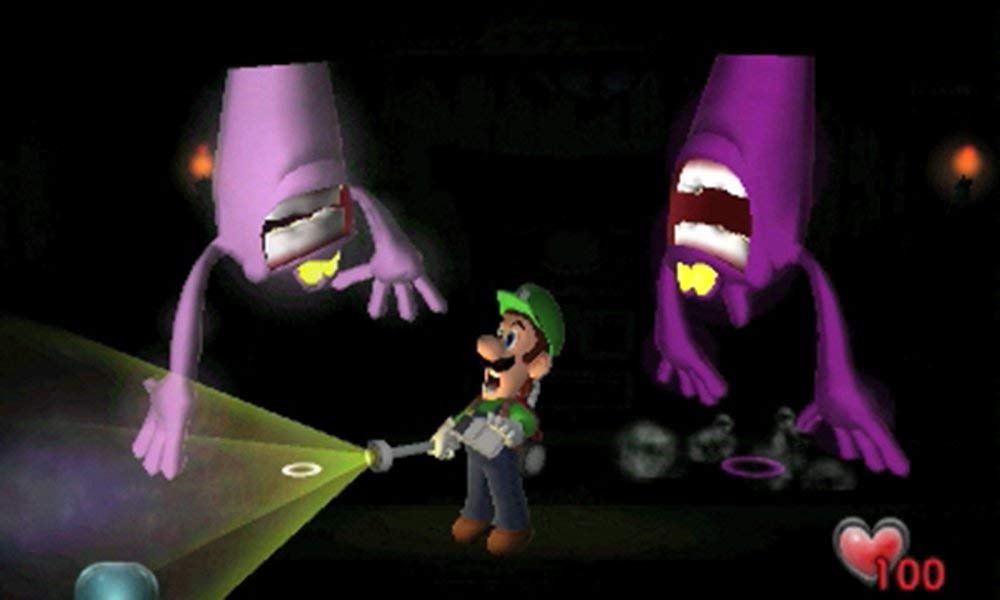
I was actually taken aback to finally see this game in 3D after all this time — the camera angle and tight rooms give the feeling of looking into a spooky little diorama. It’s been incredible to see this game come to life in 3D and I can’t help but smile to myself every time I push that little 3D slider up, knowing that this is how we were meant to experience the mansion all those years ago.
Jump in, scare, and play
When remaking a title in this day and age, you can’t help but expect a few extra features to be tacked onto the game you already know and love. The biggest one here is the addition of a co-op mode, made possible by Future E. Gadd sending a clone of Luigi back in time, apparently during the events of Dark Moon, for testing. The clone is made up of a green goo and comes equipped with his own gooey Poltergust. He starts out with only 50 health, and is prone to melting and catching on fire, but can revive every time he dies with no penalty. Co-op play in the main part of Luigi’s Mansion on 3DS requires a second copy of the game and is only available locally. Boss Rush Mode, available once you complete the story once, also has co-op play available, though this time with Download Play, allowing you to play with a friend whether or not they own their own copy.
The Hidden Mansion makes a return in this remake, albeit with a few changes, the biggest one being the increase in health for all of the ghosts, with Portrait Ghosts now having 150 health when facing them, allowing players to really test themselves against them and earn a brand new level of portrait frame, Platinum, by reducing a portrait ghosts HP down below 10 without allowing them to escape. The gallery has also changed, becoming a big, tiered room with all the portraits facing forward, making them far easier to view than in the original. Viewing a portrait allows you to see the different artwork for each of the frames, depending on how well you did when sucking up the Portrait Ghost in question. Portrait Ghosts can also be re-challenged when viewing their portraits, allowing you to chase those coveted Platinum frames if you happened to mess up your first attempt inside the mansion. Also new to the gallery is an achievement statue, giving you the opportunity to view various achievements you’ve accomplished while playing, sorted into five tiers: Beginner, Easy, Normal, Hard, and Master. Achievements measure things like how much money you’ve collected, number of ghosts caught, and if you’ve managed to collect all the gold or platinum portrait frames, providing a good amount of replayability in order to tackle them all.
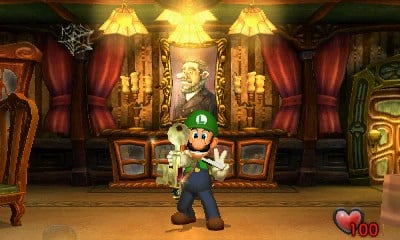
Amiibo time
A small bit of amiibo support has also been added to Luigi’s Mansion — officially, support four different amiibo. The Luigi amiibo provides a gold bone next to his health, allowing you to be revived by Polterpup during a game over, and also causes any furniture that hides a treasure-hoarding Speedy Spirit to glow blue, letting you prepare a bit more before bringing them out of hiding to capture them. Tapping a Toad amiibo will allow you to restore your health to 100 by talking to Toad in the foyer. The Boo amiibo shows you up to three Boos that have escaped your capture, allowing you to see exactly which rooms to go searching for them in. Finally, any Mario amiibo will turn all of the mansion’s poisonous mushrooms into regular old red-and-white Super Mushrooms, allowing Luigi to use them to regenerate health.
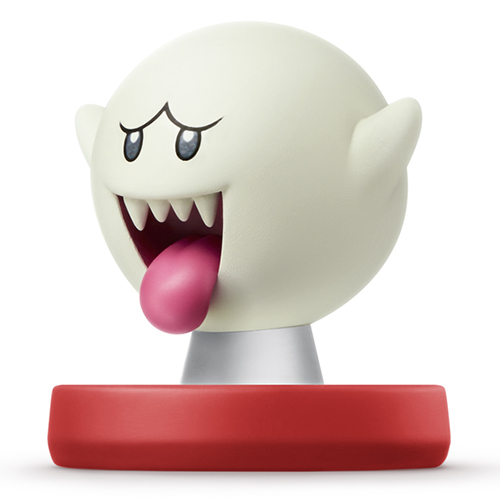
Altogether, the amiibo support provides a nice buffer for those players looking for a bit of help without locking anything behind the figures, preventing anyone who doesn’t own or isn’t interested in amiibo from being punished for not having them available.
A hauntingly good time
As far as remakes go, Luigi’s Mansion shines as a 3DS title, leaving much of what made the original so great intact while adding a few things here and there that really make it stand out on 3DS. The visuals did take a few hits, and the controls provided by the 3DS make elements a little more difficult at times, but overall I found myself enjoying my trek through the mansion once again, especially since I could finally see it all in 3D.
Leave a Comment
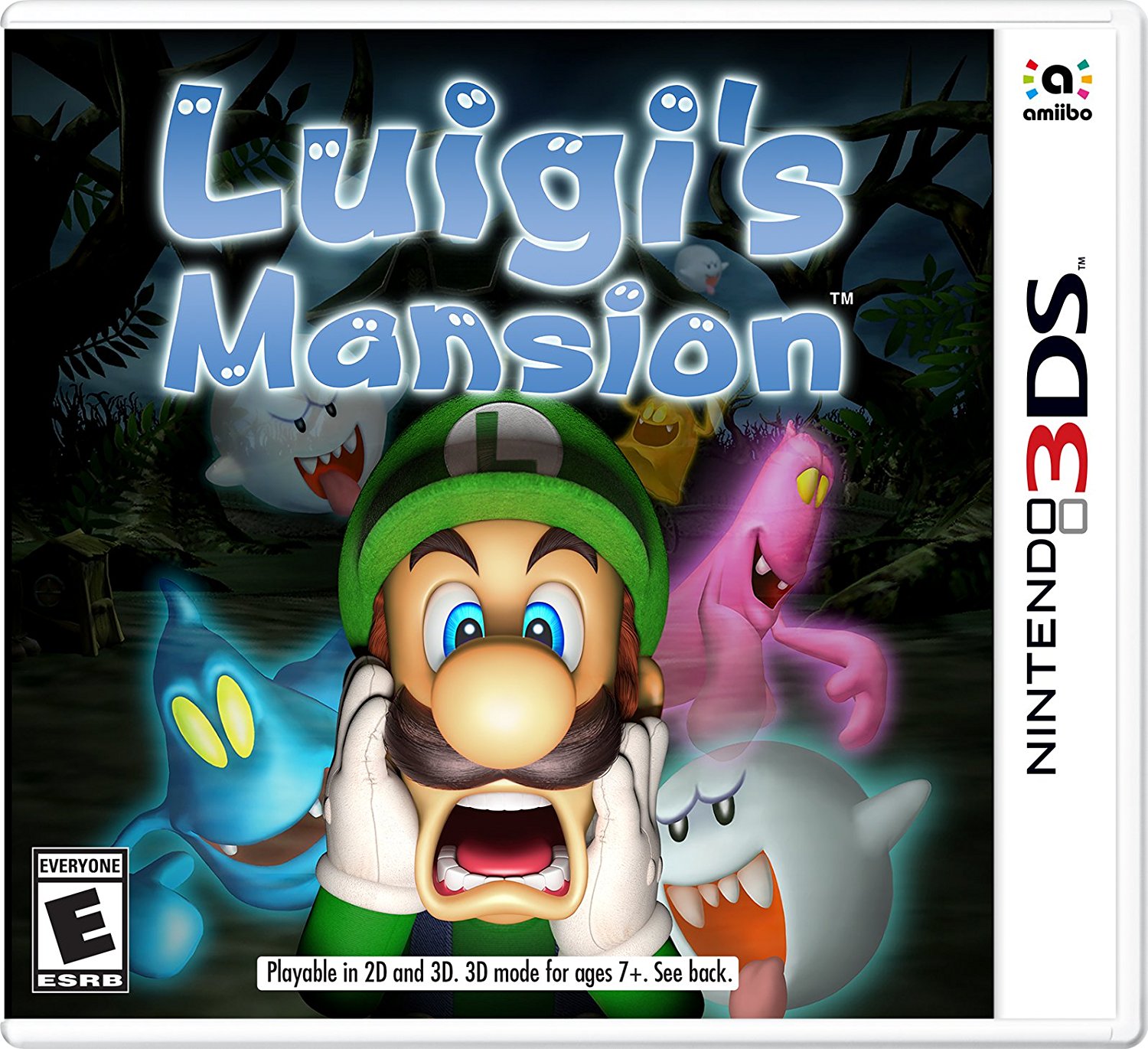
System: Nintendo 3DS
Release Date: October 12, 2018
Category: Action, Adventure
Publisher: Nintendo
Developer: Nintendo/Grezzo


